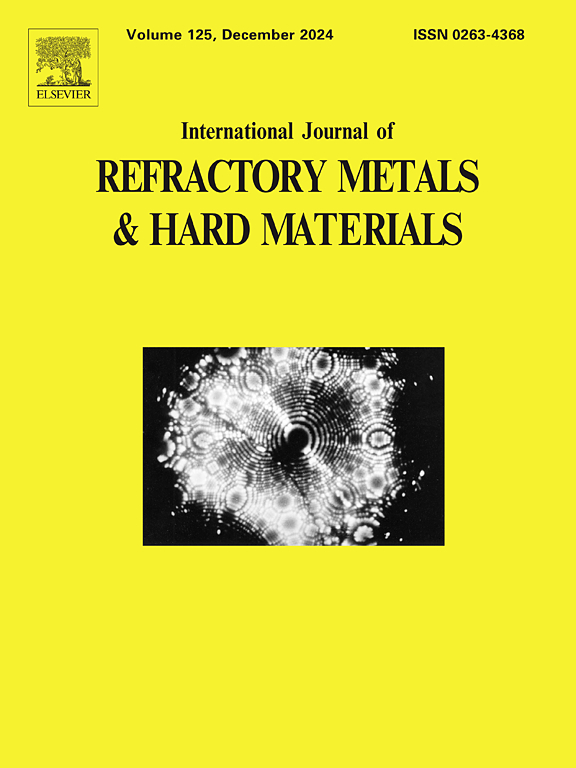New method of electrochemical pretreatment for CVD diamond coating: Cobalt removal and polishing of cemented carbide tools
IF 4.2
2区 材料科学
Q2 MATERIALS SCIENCE, MULTIDISCIPLINARY
International Journal of Refractory Metals & Hard Materials
Pub Date : 2025-05-13
DOI:10.1016/j.ijrmhm.2025.107233
引用次数: 0
Abstract
The deposition of diamond coatings on cemented carbide (WC–Co) tool surfaces using chemical vapor deposition (CVD) is an effective method for improving tool life. However, it is necessary to perform a cobalt removal pretreatment on the WC–Co tools to mitigate the catalytic graphitization effect. In this study, a pretreatment process based on electrochemical selective dissolution is proposed. By controlling the voltage and treatment time, this process enables the efficient removal of cobalt from the tool surface and simultaneous polishing of the cutting edge. Experimental results show that increasing the voltage improves the surface polishing effect, but excessive voltage leads to severe edge passivation. As treatment time increases, cobalt removal becomes faster, but once a limit is reached, further extension of the time no longer enhances cobalt removal efficiency. COMSOL Multiphysics simulations reveal that the electrochemical potential difference between cobalt and WC drives selective cobalt dissolution. After pretreatment, the tools were coated with diamond using CVD method. The resulting diamond coatings were dense, crack-free, and had a high proportion of diamond phase, demonstrating the high quality of the coatings. This proposed electrochemical pretreatment method provides an efficient, controllable, and innovative solution for the surface pretreatment of WC–Co tools.
CVD金刚石涂层电化学预处理的新方法:硬质合金刀具的钴去除和抛光
化学气相沉积法(CVD)在硬质合金(WC-Co)刀具表面沉积金刚石涂层是提高刀具寿命的有效方法。然而,有必要对WC-Co工具进行除钴预处理,以减轻催化石墨化效应。本研究提出了一种基于电化学选择性溶解的预处理工艺。通过控制电压和处理时间,该工艺可以有效地去除工具表面的钴,同时抛光切削刃。实验结果表明,提高电压可以改善表面抛光效果,但电压过高会导致严重的边缘钝化。随着处理时间的增加,钴的去除速度加快,但一旦达到一定限度,再延长处理时间不再提高钴的去除效率。COMSOL多物理场模拟表明,钴和WC之间的电化学电位差驱动了钴的选择性溶解。预处理后,采用CVD法对刀具进行金刚石涂层处理。所得金刚石涂层致密,无裂纹,金刚石相比例高,表明涂层质量高。提出的电化学预处理方法为WC-Co刀具的表面预处理提供了一种高效、可控、创新的解决方案。
本文章由计算机程序翻译,如有差异,请以英文原文为准。
求助全文
约1分钟内获得全文
求助全文
来源期刊
CiteScore
7.00
自引率
13.90%
发文量
236
审稿时长
35 days
期刊介绍:
The International Journal of Refractory Metals and Hard Materials (IJRMHM) publishes original research articles concerned with all aspects of refractory metals and hard materials. Refractory metals are defined as metals with melting points higher than 1800 °C. These are tungsten, molybdenum, chromium, tantalum, niobium, hafnium, and rhenium, as well as many compounds and alloys based thereupon. Hard materials that are included in the scope of this journal are defined as materials with hardness values higher than 1000 kg/mm2, primarily intended for applications as manufacturing tools or wear resistant components in mechanical systems. Thus they encompass carbides, nitrides and borides of metals, and related compounds. A special focus of this journal is put on the family of hardmetals, which is also known as cemented tungsten carbide, and cermets which are based on titanium carbide and carbonitrides with or without a metal binder. Ceramics and superhard materials including diamond and cubic boron nitride may also be accepted provided the subject material is presented as hard materials as defined above.

 求助内容:
求助内容: 应助结果提醒方式:
应助结果提醒方式:


